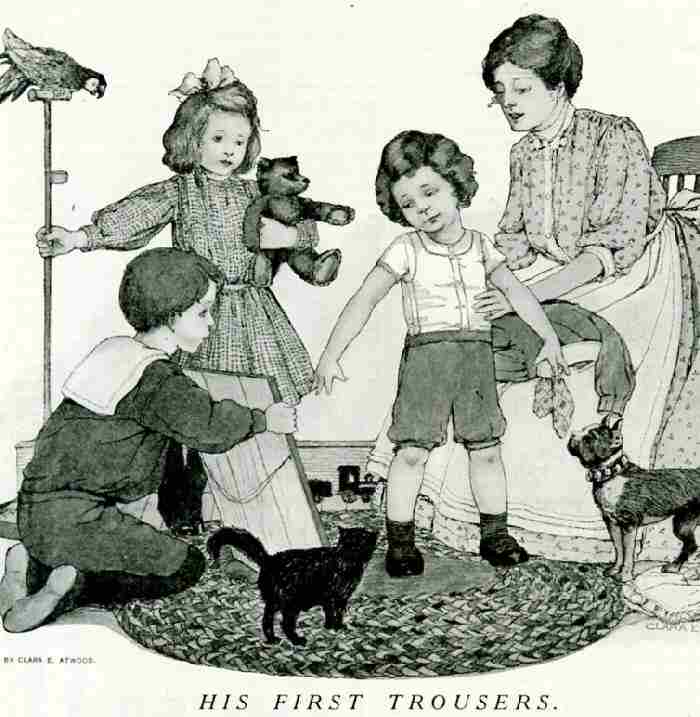
Figure 1.--Here we see an illustration by Clara E. Atwood depicting a breeching ceremony at home. Here is breaching is shown as a low-key event without father present. This illustration appeared in "The Youth's Companion" May 16, 1907, p. 241.

The Youth's Companion had fascinating articles and illustrations about contemporary domestic life. Here we see an illustration of the domestic ruitual of breaching. It is is a very informative illustration of the custom of fitting a boy for his first trousers--the process known as "breeching". The illustration comes from The Youth's Companion for 16 May 1907, p. 241, and shows a boy of about 3 years old getting his first trousers and admiring them in a mirror held by his older brother. The trousers are above-the-knee style knickers. Notice that the boy wears an underwaist over this other underwear. This buttons down the front like a vest and has strap reinforcements under the arms to which the new knickers are fastened. The boy is still young enough (about 2 1/2 or 3 years old) to wear short socks. His older brother, who appears to be about 7 or 8, wears knee pants with long black stockings--the standard trousers for older boys.
The Youth's Companion had fascinating articles and illustrations about contemporary domestic life. Here we see an illustration of the domestic ruitual of breeching. It is is a very informative illustration of the custom of fitting a boy for his first trousers--the process known as "breeching". The illustration comes from The Youth's Companion for 16 May 1907, p. 241.
One of the most important events in a boys life was his breeching. Donning trousers, or breeches in the 18th Century, signaled to the world that a boy was growing up. Dressing like his father has always been important to a boy. But it is an event that has been poorly chronicled by the social historian. In part this is because most social historians are women and they often fail to recognize the importance of the event to a boy. There are many unanswered questions about breeching. One of the most interesting is if a boy was only bought a party suit with knee pants and continued to wear dresses for a while at home when not dressing for special occasions. Or was a complete new wardrobe purchased for him. Perhaps different families did it differently. Perhaps practices varied by country or social class. Little appears to have been written ob the subject.
Breeching was a major event in the life of American and Eyropean boys in the 19th and early 20th century. Despite the importance of this event, we have few accounts of actual breeching and the extent to which ceremony may have been involved. Thus this illustration is an especially interesting find. It is tghe only contemprary depiction of breeching that we have been able to find. We do have a number of before and after photographic portraits, but this is the only actual illustration of breeching at home. Notice in the depiction here that father is not involved.
The artist's name is Clara E. Atwood. We know nothing about her at this time. HBC has quite a bit of information on illustrators, but we do not yet have any information on Atwood.
The illustration here shows a boy of about 3 years old getting his first trousers and admiring them in a mirror held by his older brother. The trousers are above-the-knee style knickers. Notice that the boy wears an underwaist over this other underwear. This buttons down the front like a vest and has strap reinforcements under the arms to which the new knickers are fastened. The boy is still young enough (about 2 1/2 or 3 years old) to wear short socks. His older brother, who appears to be about 7 or 8, wears knee pants with long black stockings--the standard trousers for older boys. The ceremony of fitting out the boy with his first trousers is depicted here as something of a family ceremony involving all of the
mother's children, the mother herself, and even the family dog. Only father is absent. This picture illustrates an important moment in a young boy's life. Before being fitted for trousers, of course, boys mostly wore dresses in 1904. The transition here is shown as coming about 2 1/2 or 3 years. This of course varied from family to family. Earlier in the 19th century it often came later.
A reader writes, "It is interesting to note that the boy goes from knickers, to straight pants to knickers and eventually long pants." Actually this progression is more complicated. Notice that here the younger boy wears knicker-like pants. He may have worn them with a tunic suit. The older boy wears a sailor suit with kneepoants. We notice that in the 1900s American boys wore both kneepants and knickers without any age connotations. The exception here were the knicker-like pants worn by younger boys with tunics. This appears to have changed by the 1910s when we see kneepants to gradually become more of a style for younger boys. By the 1920s boys including teenagers are still wearing knickers, but kneepants are going out of style and only worn by younger boys. This pattern also varied by country. We see kneepants still being worn in Europe in the 1920s. As best we can tell they were seen as a more formal styler. Knickers had more of a sporty image.
Navigate the HBC literary pages' Historical Clothing Web Site:
[Return to the Main "The Youth's Companion" page]
[Return to the main Main U.S. children's literary page]
[Return to the main Main literary page]
Navigate the Boys' Historical Clothing Web Site:
[Introduction]
[Activities]
[Biographies]
[Chronology]
[Clothing styles]
[Countries]
[Bibliographies]
[Contributions]
[FAQs]
[Glossaries]
[Satellite sites]
[Tools]
[Boys' Clothing Home]
